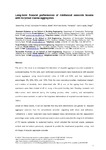Mostrar o rexistro simple do ítem
Long-term flexural performance of reinforced concrete beams with recycled coarse aggregates
| dc.contributor.author | Seara Paz, Sindy | |
| dc.contributor.author | González-Fonteboa, Belén | |
| dc.contributor.author | Martínez-Abella, Fernando | |
| dc.contributor.author | Carro-López, Diego | |
| dc.date.accessioned | 2024-07-17T16:35:41Z | |
| dc.date.available | 2024-07-17T16:35:41Z | |
| dc.date.issued | 2018 | |
| dc.identifier.citation | Seara-Paz, S., González-Fonteboa, B., Martínez-Abella, F., & Carro-López, D. (2018). Long-term flexural performance of reinforced concrete beams with recycled coarse aggregates. Construction and Building Materials, 176, 593-607. https://doi.org/10.1016/j.conbuildmat.2018.05.069 | es_ES |
| dc.identifier.uri | http://hdl.handle.net/2183/38118 | |
| dc.description.abstract | [Abstract:] The aim of this study is to investigate the behaviour of recycled aggregate concrete subjected to sustained loading. For the tests, eight reinforced concrete beams were manufactured with recycled coarse aggregate, using water-to-cement ratios of 0.50 and 0.65, and four replacement percentages: 0%, 20%, 50%, and 100%. First, the basic concrete properties, mechanical strength and modulus of elasticity, were determined after 28 d, and at the ageing load. The beam specimens were then loaded at 42 d, using a four-point bending test. Bending moments and deformations were obtained during the loading process, when cracking and serviceability conditions were reached, as well as the long-term deformations of recycled concrete beams up to 1000 d. Based on these results, it can be reported that long-term deformations are greater for recycled aggregate concrete than for conventional concrete, regarding both strain and deflection. Furthermore, a direct relationship was found between these deformations and the replacement percentage used. Lastly, code-based expressions were used to calculate the long-term deflections of RC beams subjected to sustained loading, which included the recycled coarse aggregate content and corrections previously proposed to predict the mechanical properties, creep, and shrinkage of recycled aggregate concrete. | es_ES |
| dc.description.sponsorship | The study has been funded by: “CLEAM: Clean, efficient and nice construction along its life cycle” funded by the Centre for the Technology and Industrial Development (CDTI) and led by the Group of Economical Interest CLEAM-CENIT, AIE comprising by the country’s largest construction companies (Acciona, Dragados, Ferrovial, FCC, Isolux Corsán, OHL and Sacyr) and some PYME (Informática 68, Quilosa and Martínez Segovia y asociados). “HORREO: Robust self-compacting recycled concretes: rheology in fresh state and mechanical properties (BIA2014-58063-R)” funded by the Ministry of Economy and Competitiveness. The authors declare that they have no conflict of interest. | es_ES |
| dc.language.iso | eng | es_ES |
| dc.publisher | Elsevier | es_ES |
| dc.relation | info:eu-repo/grantAgreement/MINECO/Plan Estatal de Investigación Científica y Técnica y de Innovación 2013-2016/BIA2014-58063-R/ES/HORMIGONES RECICLADOS AUTOCOMPACTANTES ROBUSTOS: REOLOGIA EN ESTADO FRESCO Y PROPIEDADES MECANICAS | es_ES |
| dc.relation.uri | https://doi.org/10.1016/j.conbuildmat.2018.05.069 | es_ES |
| dc.rights | Atribución-NoComercial-SinDerivadas 3.0 España | es_ES |
| dc.rights.uri | http://creativecommons.org/licenses/by-nc-nd/3.0/es/ | * |
| dc.subject | Recycled aggregate concrete | es_ES |
| dc.subject | Flexural performance | es_ES |
| dc.subject | Long-term deflection | es_ES |
| dc.subject | Long-term strain | es_ES |
| dc.subject | Sustained load | es_ES |
| dc.title | Long-term flexural performance of reinforced concrete beams with recycled coarse aggregates | es_ES |
| dc.type | info:eu-repo/semantics/article | es_ES |
| dc.rights.access | info:eu-repo/semantics/openAccess | es_ES |
| UDC.journalTitle | Construction and Building Materials | es_ES |
| UDC.volume | 176 | es_ES |
| UDC.startPage | 593 | es_ES |
| UDC.endPage | 607 | es_ES |
| dc.identifier.doi | 10.1016/j.conbuildmat.2018.05.069 |






